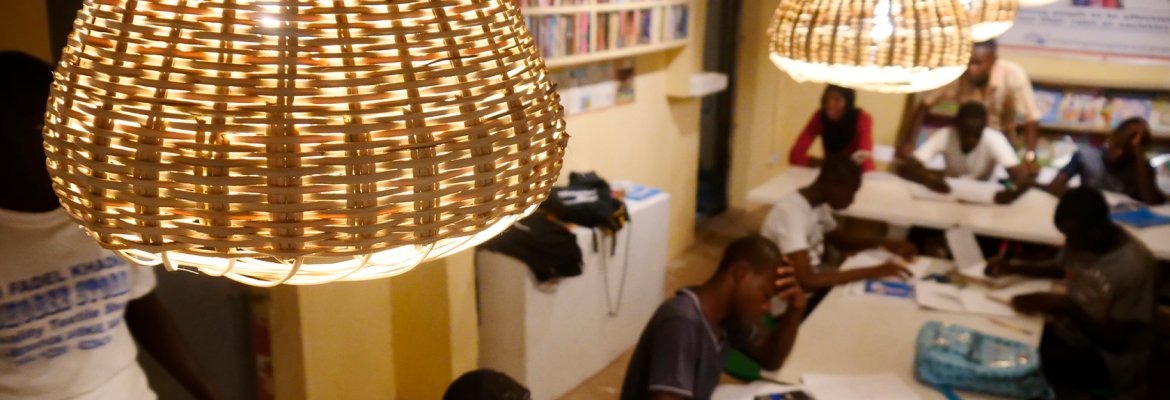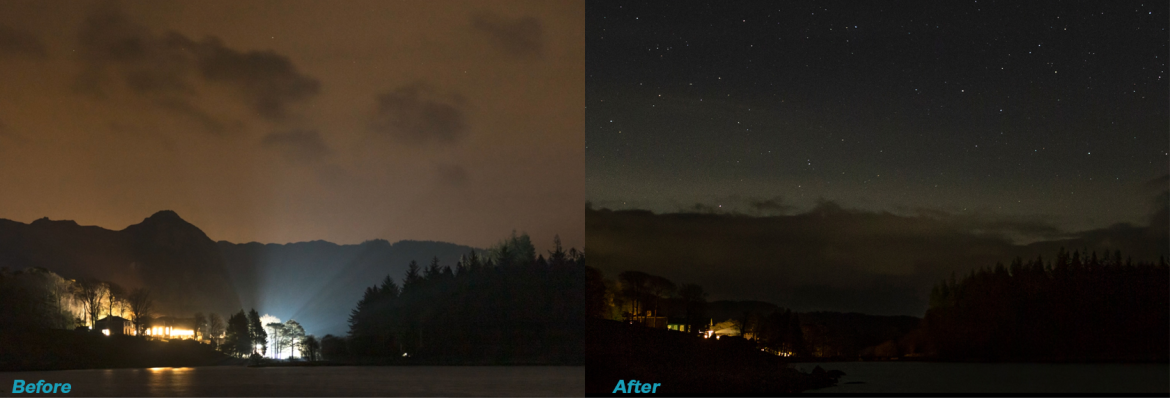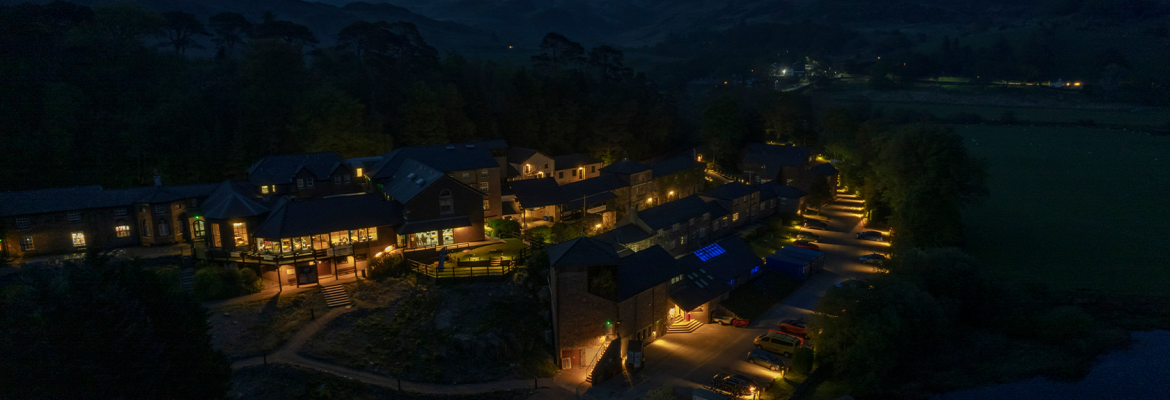Beacons of Light: Kerem Asfuroglu
September 2023
September 2023
DW Windsor is powered by people with a shared passion for light, committed to delivering outstanding lighting solutions. To celebrate those who share our passion, we've collected more individuals who positively impact our community and shine a light on our industry. Through this series of interviews, we are highlighting a number of unique and inspiring people who are leading the way as Beacons of Light.
Kerem, an award-winning lighting designer and graphic artist, is the Founder of Dark Source – a London-based lighting design studio which specialises in dark sky-friendly lighting. The studio develops unique lighting concepts to enhance the night-time experience with an environmental ethos.
We met with Kerem to discuss his passions, his past and his future, including the preservation of dark skies and his philosophy towards exterior and architectural lighting, and the award-winning Plas Y Brenin project.
I began by studying Interior & Furniture Design at Anadolu University in Turkey before being introduced to lighting design in my last year of studies during an exchange year in Hildesheim, Germany. Throughout my journey as a young designer, I realised how powerful light and dark can be in creating an ambience and experience. This brought me back to Germany to study for a Master’s in Architectural Lighting Design at Wismar University. It proved to be the wisest decision I ever made in my 20s.
 |
Kerem AsfurogluKerem is an award-winning designer who founded Dark Source in 2019. Prior to this, Kerem was a guest lecturer at Fakultät Gestaltung der Hochschule Wismar and a lighting designer at Speirs Major. |
My lightbulb moment occurred in late 2018 when I left my role at Speirs Major after 7 1/2 years. You could say I was having a sort of early midlife crisis as I was yearning for a purpose. My passion started leaning towards bringing small but meaningful improvements to people’s lives by making lighting design accessible.
I previously volunteered at a community centre called Kori in North London from 2013 - 2014, where I mentored two teenagers. It was an amazing experience which opened my eyes to the importance of community engagement. Kori offered another programme called the Vessel which helped people to develop and deliver projects in one of their partner countries, Gambia. After a successful fundraiser, I went there to train 40 local electricians about solar power and lighting design to help increase their employment potential. We then worked with the trainees to design and install solar lighting for a 24-hour accessible community library which provided local children with a safe place to study.
After all these years as an experienced lighting designer, my lightbulb moment came to me on the last day when we were taking portfolio photos of the finished project. When we stepped outside, we realised that the power had gone out in the town, but the children at the library hadn’t noticed and were able to continue studying thanks to the solar lighting. This was my first-hand experience of how quickly design could improve someone’s quality of life. It changed my attitude towards the accessibility of design whilst making social and environmental values rank very high in my agenda, eventually leading to my particular approach in dark skies and community-led projects.

Photo credit: Ebru Edgeworth
My biggest challenge is a self-inflicted and conflicting one: embracing a future with less light. Lighting is such a visually expressive language, and there are a lot of set expectations from light in terms of how it should perform and conform. But it’s unrealistic to expect light to be a magic bullet to fix every problem in life. Sometimes lighting design gets too carried away by meeting expectations that it over-delivers and stops challenging convictions.
I try my best to communicate an alternative vision which challenges me and the status quo. I try to put myself out of my comfort zone on every project. I try using an accessible language and credible argument which communicates why these issues should matter. I cannot say that I have mastered any of these yet, but I haven’t given up trying.
Even though I studied architectural lighting, I now have a different appreciation of what architecture is: more horizontal than vertical. With exterior spaces, it’s indeed important to create engaging and inviting spaces. My biggest passion now is creating accessible experiences which actually take the public’s opinion and the environment’s needs into consideration. We need to pare back to the main stakeholders that the architecture is made for and impacts upon: people and biodiversity. Artificial lighting is developed for humans; nowhere else in the natural world there is a demand for electric lighting. My philosophy of lighting outdoor spaces is enhancing the visual experience proportionate to its social and environmental sustainability. We need to explore the holistic potential of what light and the absence of light can offer to us. This cannot be done by maxing out on using light as a visual embellishment tool.
We are recognising the negative impact of light pollution and how it is accelerating at an alarming rate. Light comes at an economic, well-being and environmental cost. 6% of the global power consumption can be attributed to lighting. It’s literally the most visible form of energy consumption, and its impact on the environment is evident. At no point in our history had we produced and consumed more light. Now that we have a clear understanding of its adverse effects, if we don’t do anything about it, we would be actively choosing to be a part of the problem.
Dark Skies is also about dark landscapes. It is about being respectful of the natural night, which is in scarcity due to the excessive and wasteful use of light. This requires a shift in our perspective in order to prove that it’s possible for us to create a better nighttime environment for all earthlings, not only for us humans.
I start by asking myself if light is necessary. Designed light should be utilised judiciously in order to add social and environmental value, broadening the spectrum of sustainability beyond the visual language.
Snowdonia National Park Authority, in collaboration with Prosiect Nos, commissioned Dark Source to develop a lighting design that could restore the dark skies and tackle the growing concerns for the region, known as a Dark Sky Reserve since 2015. Warm-coloured, glare-free, low-intensity lighting was utilised to meet dark sky-friendly requirements, along with high energy efficiency and lamp-life criteria to maximise the savings.
Initially envisaged as a re-lighting scheme, this project quickly turned into an enhancement scheme which showcased that dark sky-friendly lighting can also be visually intriguing and inviting. I have been blown away by the level of support received from the design community. This project demonstrates a yearning for change that is now more prominent than ever. I feel incredibly grateful that the message we were trying to give was well-received and appreciated to this extent.

Photo credit: Karl Midlane & Dylan Parry Evans
Awarded the coveted [d]arc awards ‘Best of the Best’ for 2022, pictured below, the Plas Y Brenin project with lighting design by Dark Source won the Spaces – Low Budget category. This award is given to the project that received the most votes out of all the project category winners.
I am lucky enough to be working on my dream project as we speak. It is a dark sky masterplan project in Newport, Ireland which takes a holistic view of how the lighting of a town should perform in order to become a dark sky community. I feel very lucky to be working with such a progressive community on this genre-defining project. We have just completed phase 1, which involved the re-lighting of St Patrick’s Church and its surroundings. You can see more here.
Be patient, watch and learn. Be tenacious and curious. Stick to your path, no matter how fast or slow; as long as you are covering the ground, the future will reveal itself to you. Not giving up is the most important part of arriving at any destination.
My advice to younger designers is to look at the big picture and understand what they are expecting from this realm. Apply yourself and be willing to step outside your comfort zone. Be inquisitive and question things, especially your values. Try to take meaningful actions towards your goals in life.
Don’t be a moth. Don’t get blinded by the light. Allow nature to breathe.

Photo credit: Dylan Parry Evans
My beacon of dark, rather than light, has sadly just passed away. I am lucky enough to have worked with and been inspired by lots of people within the lighting industry, but my beacon was someone from the dark side. His name was Bob Mizon, and he was the Coordinator for the British Astronomical Association’s Commission for Dark Skies. He has done incredible work raising awareness about light pollution and spreading the importance of dark skies within the UK and beyond. His vision has inspired me greatly. He will be sorely missed, but his work and achievements will live on through people that continue to carry his beacon of darkness.